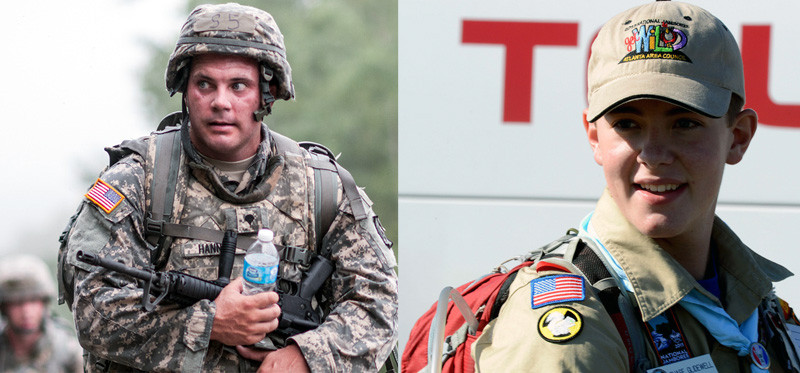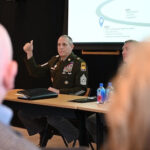Have you ever noticed the American flag patch on a Boy Scout Uniform and compared it to the one on a U.S. soldier’s uniform? At first glance, they might seem the same – both proudly displaying the stars and stripes. However, a closer look reveals a key difference: the orientation of the flag. On a Boy Scout uniform, the blue field of stars is on the left, while on a soldier’s uniform, it’s on the right. This often leads to the question: which way is correct?
 Boy Scout and Soldier Flag Patches
Boy Scout and Soldier Flag Patches
The answer, surprisingly, is that both orientations are correct. The Boy Scouts of America (BSA) pre-sews the American flag patch onto all Cub Scout, Boy Scout, and Venturing uniform shirts with the stars to the left as you look at it, and this placement is indeed correct according to their guidelines.
This placement sometimes raises questions, particularly from those with military backgrounds. They correctly point out that the military reverses the flag, positioning the star field to the right. The military rationale is that the flag should appear as if it’s flying forward as the soldier moves into battle, not retreating. Imagine a flag carried on a pole moving forward – this visual explains the military’s “reverse-field” flag.
The Boy Scouts organization is aware of this difference and addresses it directly. The Boy Scout Handbook clearly states that the flag patch is placed “with the blue field to the flag’s own right (to the left, as someone views it),” explicitly referencing the guidelines of the U.S. Flag Code.
To delve deeper into this, let’s consider the expert opinion of Peter Self, a leader in youth development with the BSA. He addressed an inquiry from a Scouter who was also a U.S. Army staff sergeant, providing a comprehensive explanation.
The Scouter’s letter highlighted the apparent contradiction: both Scouts and soldiers wear the flag on their right shoulder, but with different orientations. He explained the military’s reasoning behind the reversed flag – to symbolize moving forward, with the flag appearing to fly in the wind as the soldier advances. He then questioned why the Boy Scout uniform displayed the flag in the “opposite” direction, suggesting it might give the impression of “retreating.” He emphasized the values instilled by Scouting, such as duty and service, and proposed aligning the Scout uniform flag with the military’s.
Peter Self’s detailed response clarified the regulations and reasoning behind both approaches. He first addressed the fundamental right of both organizations to wear the flag. Title 4 of the U.S. Code, known as the Flag Code, grants permission to “military personnel, firemen, policemen, and members of patriotic organizations” to affix a flag patch to their uniforms. The Boy Scouts, as a patriotic organization, clearly fall under this authorization.
Crucially, while Title 4 outlines flag display protocols for various settings, it lacks specific guidance on flag patch orientation on clothing. In the absence of such specific direction, the BSA defaults to the general convention of displaying the flag with the canton (star field) in the upper left corner.
The U.S. Army’s reversed flag, however, is explicitly defined in U.S. Army Regulation 670-1. This regulation dictates that “the star field faces forward, or to the flag’s own right,” creating the effect of the flag moving forward with the wearer. This regulation is unique to the military and provides the specific justification for their reversed flag.
Could the Boy Scouts simply adopt the military’s reversed flag for their uniform? Peter Self explained that the BSA is prohibited from imitating U.S. Army, Navy, or Marine Corps uniforms, according to their Congressional Charter. Since the reversed flag is a distinctive feature of military uniforms, adopting it for the Boy Scout uniform would be considered an imitation and is therefore not permissible.
In conclusion, the seemingly different orientations of the American flag patch on Boy Scout uniforms and military uniforms are both correct within their respective contexts and regulations. The Boy Scout uniform adheres to the U.S. Flag Code’s general display conventions and BSA regulations, while the military uniform follows specific U.S. Army guidelines to symbolize forward movement. Understanding these distinctions highlights the unique purposes and regulations governing each organization, while both proudly display the American flag as a symbol of patriotism and service.

